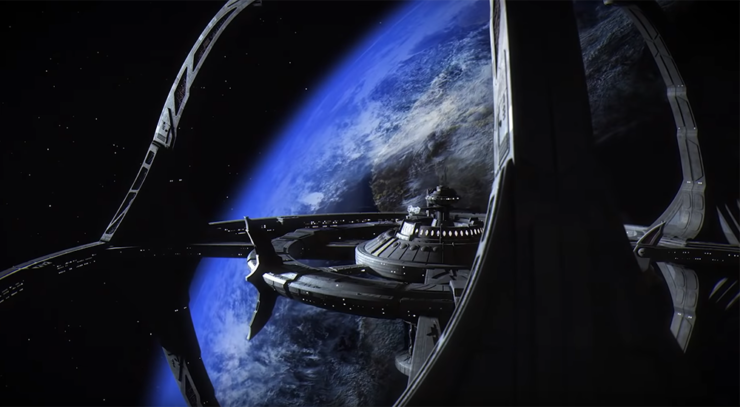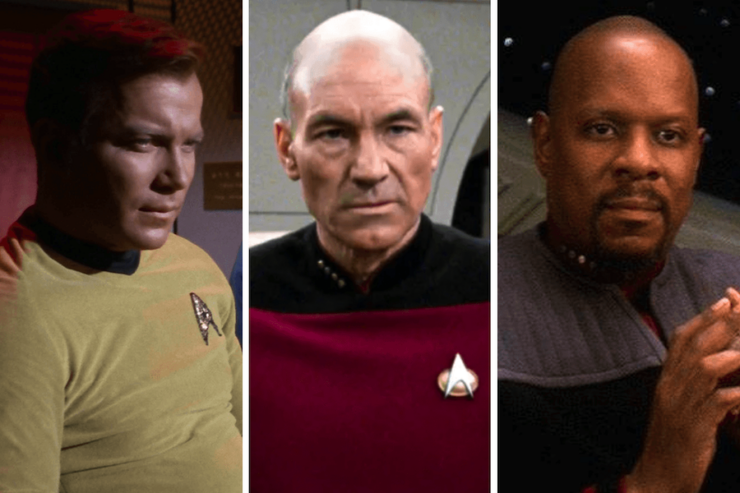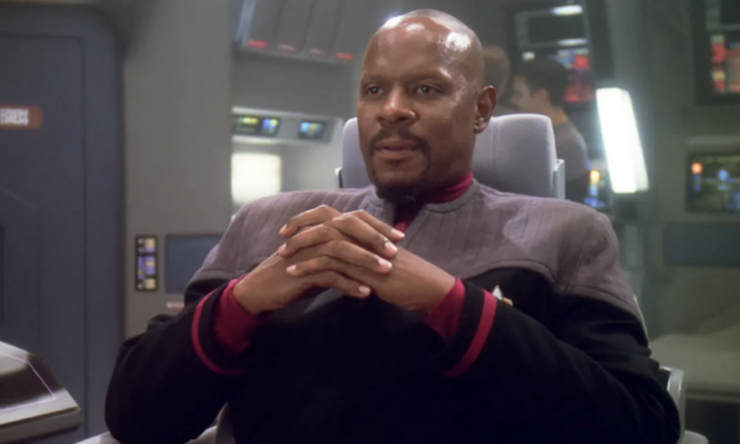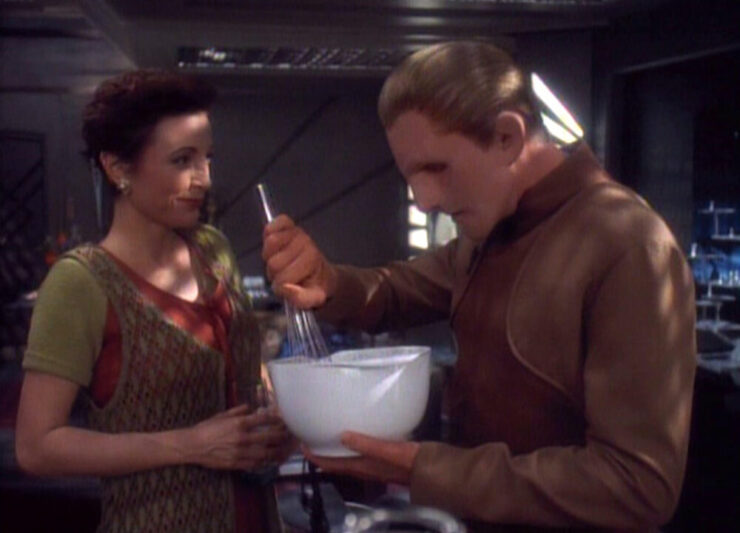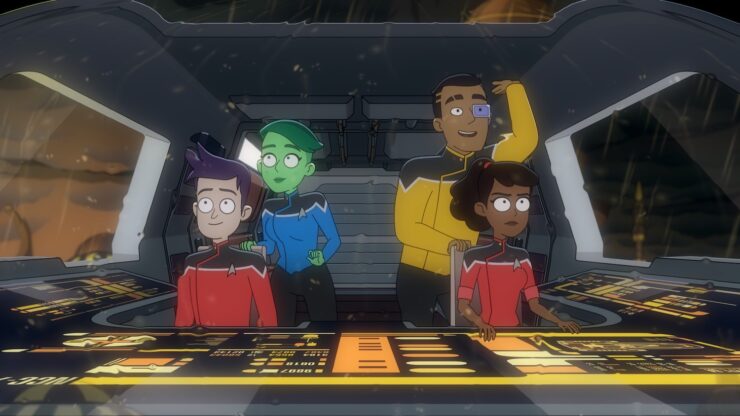We hereby present this review of the documentary What We Left Behind in the same format as “The Star Trek: Deep Space Nine Rewatch” by the same author that ran on this site from 2013-2015, and a similar format to the current “Star Trek: Deep Space Nine Reread” of the post-finale DS9 fiction.
What We Left Behind: Looking Back at Deep Space Nine
Directed by Ira Steven Behr
Original release date: May 13, 2019
Stardate: n/a
Station log. Ira Steven Behr, the show-runner of Star Trek: Deep Space Nine for most of its run, gets together a massive number of people involved with the show to talk about it on the occasion of the show’s conclusion happening twenty years ago.
The documentary is bookended with guys in tuxedos singing, none of whom are James Darren (Vic Fontaine). We start with Max Grodénchik (Rom) singing a song about the show, and we end with Grodénchik, Armin Shimerman (Quark), and Casey Biggs (Damar) singing another song.
Between those musical numbers, we get lots of people talking about DS9. We get actors—not just the regulars, but the recurring regulars, even a grown-up Hana Hatae (Molly O’Brien)—we get writers, we get producers, we get production staff, we get people who’ve written about the show.
And we get fans: lots and lots of fans are interviewed for the documentary.
And we get non-fans: on several occasions, the actors read negative comments about the show from the Internet.
Some of the interviews are older—notably, there is no new footage of Avery Brooks (Sisko), though older interviews of him are used; also we see some old interviews with the late Cecily Adams (Ishka)—and some of them pair off or go in groups.
Behr conducts most of the interviews himself, and he also talks extensively about the show.
In addition there are two unusual features: One is the debuting of new remastered battle footage from the sixth-season episode “Sacrifice of Angels,” as well as remastering for high-definition of all the clips used in the documentary. (This is by way of trying to convince CBS Home Video to release DS9 in HD.) The other is a bunch of members of the writing staff—Behr, Ronald D. Moore, Rene Echevarria, Hans Beimler, and Robert Hewitt Wolfe—plotting out a theoretical season 8, which would be done now, twenty years after season 7 ended.
Finally, as the credits list all the Indie Go-Go supporters, Behr and Nana Visitor (Kira Nerys) go over all the things that got left out of the final documentary.
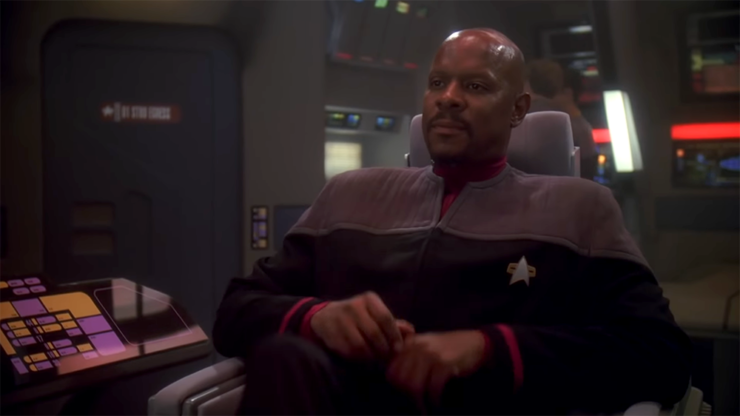
The Sisko is of Bajor. While Brooks declined to be interviewed for the documentary, other past interviews with him were used. Brooks also reportedly urged Behr not to make it just talking heads, advice Behr took to heart.
Don’t ask my opinion next time. Visitor talks frankly about the show, most impressively calling out Behr for the rather idiotic notion of having Kira get into a relationship with Marc Alaimo’s Gul Dukat. Visitor, who actually understood that this was the equivalent of putting Anne Frank into a relationship with Adolf Hitler, objected very very very loudly, and they switched gears and made it Kira’s mother having a relationship with Dukat, as revealed in “Wrongs Darker than Death or Night.”
There is no honor in being pummeled. Michael Dorn gets to tell the story of how much he enjoyed “Apocalypse Rising,” where Brooks, René Auberjonois (Odo), and Colm Meaney (Miles O’Brien) all had to wear Klingon makeup—and also how much Meaney complained about it, to the point that Dorn requested that they never put prosthetics on Meaney ever again.
The producers and other cast members are also very up-front about how much they resented the insertion of a Next Generation cast member into the show in the fourth season—though they were also quick to say how much they liked and respected and enjoyed working with Dorn.
Preservation of mass and energy is for wimps. Auberjonois jokes that being on DS9 means that when he dies, the obituary won’t read that he was the guy who played Clayton Endicott III on Benson, but rather Odo. He also more seriously talks about how very painful some of the emotional scenes were.
Rules of Acquisition. Shimerman talks about how, every time there was a Ferengi episode, he would invite all the supporting players and guest stars over to his house before shooting started to have dinner and all get to know each other. It made for stronger camaraderie on set. Chase Masterson (Leeta) in particular waxes rhapsodic about how awesome they were.
The slug in your belly. Both Terry Farrell (Jadzia Dax) and Nicole deBoer (Ezri Dax) talk openly about the issues they had. Farrell is very open about how she felt she needed to leave the show after the sixth season, and deBoer is equally open about how she couldn’t let the knee-jerk objections to her very presence, replacing a beloved character, get to her. Auberjonois is also particularly effusive in his praise of how Farrell grew as an actor during her time on the show.
Plain, simple. Andrew J. Robinson (Garak) admits what we’ve all believed since “Past Prologue” in 1993: Garak was totally hitting on Bashir from jump and wanted to sleep with him.
For Cardassia! Alaimo complains that nobody ever told him he did a good job while he was playing Dukat, with Behr explaining patiently that the way they showed him he was doing a good job was having him come back so often.
Victory is life. Behr and the other writers all discuss the genesis of the Dominion, and how they wanted a foe that would be a nation from the Gamma Quadrant, but not all a single species: you’d have the Vorta, who were the slimy bureaucrats, the Changelings, who can be anyone, and the Jem’Hadar, the badass soldiers.
Tough little ship. One of the many conversations between Behr and co-creator/executive producer Rick Berman involve the Defiant, which Berman loudly objected to adding, because he didn’t like the idea of a warship and he didn’t like the idea of DS9 having a ship when the whole point was that it was the show that wasn’t on a ship. It’s one of a couple of occasions where Berman—who has not been in charge of Trek for more than a decade now—admits that he was wrong about something relating to DS9 that Behr wanted to do.
No sex, please, we’re Starfleet. Behr is, at one point, doing a checklist of things the show did right and wrong, and he refuses to accept that the show did right by the LGBTQ+ community. While he was happy with “Rejoined,” one episode out of 173 is woefully inadequate. They kept Garak in the closet and their attempt at doing a transsexual, Quark in “Profit and Lace,” is best forgotten quickly.
Keep your ears open.
“If man is to survive, he will have learned to take a delight in the essential differences between men and between cultures.”
—a Gene Roddenberry quote displayed at one point in the doc, which is pretty much Star Trek in general and DS9 in particular in a nutshell
Welcome aboard. It’s worth mentioning who isn’t in this documentary: we hear nothing from Rosalind Chao, Louise Fletcher, Salome Jens, Mark Allen Shepherd, Camille Saviola, Susanna Thompson, Harris Yulin, Clarence Williams III (though Jeffrey Combs does talk about how cool it was that Weyoun was killed by the lead from The Mod Squad in his first appearance as that character), or Iggy Pop (though the lack of Pop in the documentary is lampshaded by Behr and Visitor over the end credits).
Walk with the Prophets. There is a lot to like about this documentary. It takes a serious look at the show that the documentary itself admits is the red-headed stepchild of Star Trek. It was always the “other” show, either the one secondary to Next Generation (which came first) or to Voyager (which was the flagship of a new network, UPN).
In particular, I admire how it goes head-on to talk about what the show did right, what the show did wrong, how prescient it was, and the ways in which it broke new ground.
Buy the Book


The Future of Another Timeline
Behr admits to being pissed off when he saw a documentary that discussed how unique it was for Homicide: Life on the Street to have entire scenes with only African-American characters in them, thus ignoring that DS9 (which aired at the same time) had such scenes all the time. And a good portion of the documentary’s running time is given over to the importance of Benjamin Sisko as a character and as a role model, but also of the difficulties they had having a black lead.
They also discuss at length the character of Kira in particular and the issue of terrorism in general. If the show was made a decade later, it would’ve been much different, as attitudes toward terrorism changed after the events of September 2001. And those events also made “Homefront“/”Paradise Lost” much more prescient.
In addition, the rise in white nationalism over the past few years is given play as well, with footage of President Trump’s “very fine people on both sides” speech to remind us that things aren’t that much better than they were in the 1953 New York portrayed in “Far Beyond the Stars.”
“Far Beyond…” is one of the few single episodes that’s given a spotlight, as the documentary focuses more on general matters than specific episodes.
This documentary includes new remastered footage—which is nice, I guess. I get why they want to convince CBS to put out the show in HD, but the remastered stuff just left me completely cold. (Then again, I never got the remastered original series, nor the remastered Red Dwarf, and I still would prefer to own the original cuts of the Star Wars movies.) I just don’t think the remastering adds anything that matters.
The big thing, though, that makes this documentary stand out from most others, is Behr running a writer’s room for a totally hypothetical eighth season of the show, complete with animated bits to illustrate the ideas they bat around.
Now, of course, the Star Trek novels published by Simon & Schuster did their own continuation of the show, and I participated in that, writing a couple of novels, a novella, and some other ancillary material relating to the post-finale books. So I’m a bit biased, having already been deeply involved in the plotting of a similar type of story.
Having said that, Behr and the crew were plotting a TV show, not a series of novels, and they were also proceeding from the notion that they’re picking it up 20 years later. So of course it’s going to be different.
As it turns out, it’s not all different, as both the fiction and the TV writers room posited the notion that Kira would become a vedek. I was no longer involved in the DS9 fiction when that particular character shift became part of the prose line, and I have to admit that it never made any sense to me, and it makes as little sense in the writers room. Especially since Behr et al don’t actually give Kira any plot points in their new pilot that requires her to be a vedek. Hell, they even have her still operating out of the station-master’s office, and she’s acting like she’s still in charge of the station. Making her a vedek is a pointless move in the story they come up with, and she could still be a high-ranking member of the Bajoran Militia, and it wouldn’t actually change the story.
Plus, Sisko is still off with the Prophets.
One of the biggest issues with “What You Leave Behind,” the show’s finale, is that it turned Sisko into a person who would abandon his pregnant wife. After spending seven years showing us that Sisko is the best fucking father ever, they had him leave Kasidy Yates alone to raise their kid. It was Brooks who insisted that they alter it so that he would come back to Yates eventually so he wouldn’t be the stereotype of the black man who abandons his family.
In this season 8, the room full of white writers blithely don’t have Sisko returning until now, two decades on. Oh, and one of their supporting characters is Sisko and Yates’s son, all grow’d up and in Starfleet. So, after their star specifically told them not to turn their great father into someone who’d abandon his family, they double down on it and have him completely miss his second son’s entire childhood. All this in the same documentary that spent a good chunk of its first half-hour talking about how great Sisko was, including in particular that he was a great father.
Leaving aside any other consideration, this is a great way to guarantee that Brooks won’t touch your reunion with a ten-foot pole.
On top of that, Bajor still isn’t with the Federation, which Behr lists as a feature, not a bug. In an interview a while back, Behr said that the fact that the novels did have Bajor join the Federation (in Unity by S.D. Perry) shows that the people involved in the novels didn’t understand DS9 at all. My only response (at least that doesn’t involve a middle finger directed toward my fellow Bronx native) is that Behr seems not to understand basic storytelling. The entire show was set up to end with Bajor joining the Federation, starting with Picard explicitly telling Sisko that was his mission in “Emissary,” all the way to the closing arc of the series with Kira wearing a Starfleet uniform.
In addition, Section 31 is playing a part in their new story idea, because apparently nobody can write a Trek story anymore without throwing 31 into it. They were in the novels, they were in Enterprise, they were in Into Darkness, they were in Discovery, and they’re getting their own damn series. Sigh.
On the one hand, this documentary goes on way too long. An hour in, I was starting to wonder when they’d wrap it up, but I was only halfway there. On the other hand, as Behr tells Visitor over the closing credits, they cut out a ton of stuff, and looking at what’s actually in there, I can’t see anything good to get rid of. Even the season 8 writers room, for all its flaws, is one of the things that makes the documentary unique.
This is a fun look back at a wonderful show. The one thing that shines through in every interview, in every conversation, is the sheer joy that everyone involved in making the show took in the doing of it. This was a labor of love for everyone involved, and it shines through from the heartfelt comments from Aron Eisenberg (Nog) about his character’s arc and in particular how positively veterans responded to how Nog dealt with his PTSD after having his leg blown off; to Visitor’s passion for the character of Kira Nerys; to Auberjonois’s sober musings on the show’s writing; to Robinson’s frank discussion of Garak’s fluid sexuality.
If you loved DS9, watch this movie. If you want to know what all the fuss is about regarding DS9—well, I’d say try watching the show first, and then watch this movie, but whatever. This is a nifty coda to a great series.
Warp factor rating: 8
Keith R.A. DeCandido rewatched all of DS9 for this site from 2013-2015, and also has written several works of DS9 fiction, including the novel Demons of Air and Darkness, the short novel Ferenginar: Satisfaction Is Not Guaranteed in Worlds of DS9 Volume 3, the novella “Horn and Ivory” in Gateways: What Lay Beyond, and the short story “Broken Oaths” in Prophecy and Change, as well as lots of DS9-adjacent material. He’s continued to write articles for this site, including the weekly “4-Color to 35-Millimeter: The Great Superhero Movie Rewatch,” as well as reviews of new episodes of Star Trek: Discovery and Short Treks as they’re released.










